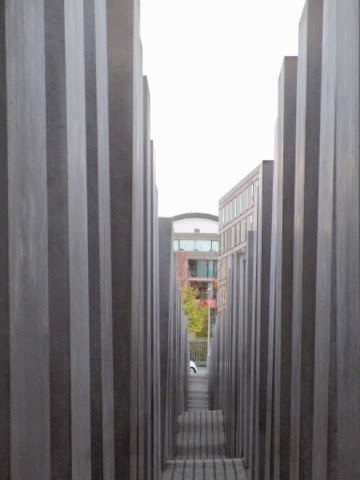To write about the history of Berlin, I could write several volumes and barely touch the surface. Berliner history is as long and as rich as it's culture is varied and proud. I often forget how much I love being in Berlin until I arrive. This held true on my most recent visit to the Hauptstadt.
I arrived in Berlin and from the main train station walked over in the direction of the Reichstag. My goal was to spend time focusing on the historical sites in this area, but I found myself quickly drawn to memorials.
Berlin is not shy about its past, nor do they try and gloss it over. It seems that they try to apologize and prevent people from forgetting what can happen when one has unchecked power. It takes a lot of courage for a city to be this bold.
The first memorial I saw was right outside the Reichstag. I've seen it before, but have never really taken the time to get to know what it represents. This memorial is a row of jagged stones. On the edge of each one is a name and a place. Often this place is a concentration camp. This is a memorial for members of the Weimar Republic's government who did not buy into the Nazi government's form of ruling. The Weimar Republic, was a weak government that governed Germany between 1919 and 1933.
Heading from the Reichstag to the Brandenburg Gate, I encountered a second memorial. To me, this was new, I'd not seen it before. This memorial was a quiet pond in the park. Soft music played in the air and and placards described the victims. This was a memorial for the Sinta and Roma, more commonly known as gypsies, killed during the Holocaust. Sinta and Roma rank second in numbers murdered during the Nazi Regime.
In 2005, I visited Berlin and a new memorial was in the process of being built. In 2010 I first had a chance to see it in its completed form. I went back to see it again. The Jewish memorial is composed of a number of square columns ranging in height from short to tall. The land it is on is composed of small hills and the columns are placed together narrowly so that the "streets" they form appear to go on for miles. The idea is to provide an image that speaks to the sheer number of individuals of all ages who were murdered in the concentration camps. The overall layout is quite effective. However, the layout is also one that takes away from the solemnity of the memorial. It is common to find people (especially kids) chasing each other throughout the "streets and alleys".
Not every memorial is for victims of the Holocaust. I also visited memorials to victims of WWI, victims who tried to escape East Berlin, victims of September 11th, memorials of those brave enough to protest and take a stand for the rights of themselves and others. Berlin is a vibrant city, it speaks of all the future has to offer, but does not allow the past to be forgotten









No comments:
Post a Comment